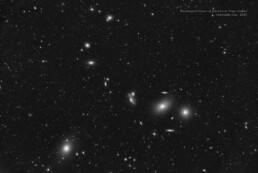Sculptor Galaxy NGC253
NGC 253 is one of the brightest visible spiral galaxies, but also one of the most dusty. It is often called a Silver Coin galaxy due to its look in…
NGC185 and NGC147 nearby galaxies
Most of you are probably familiar with the Andromeda Galaxy (M31). You might also know that it has two prominent satellite galaxies – M32 and…
Messier 106 and Zwicky 5032 galaxy cluster
Most of the astronomy amateurs are probably familiar with the Messier 106 galaxy. This object has no fancy nickname, but M106 is large and rich in…
IC 2574 Coddington's Nebula galaxy
IC2574 is quite a faint object, so it was never a part of the New General Catalogue. It is a dwarf galaxy discovered by Edwin Foster Coddington in…
Abell 779 galaxy cluster in Lynx
Abell 779 galaxy cluster is not a well-known target, because galaxy clusters are not a well-known targets for astronomy amateurs anyway.…
NGC6946 Fireworks Galaxy
I have already approached the NGC6946 Fireworks Galaxy, but only once – twelve years ago. I used a Canon 20D camera then, and a popular 150mm…
Markarian's Chain of galaxies
Markarian’s Chain consists of a line of several galaxies that curves north and east from M84 and M86. It extends well over 1 degree and reaches…
Coma Cluster of galaxies
Eight years passed since the night I imaged the Coma Cluster for the first time. It was 6 inches then, and 10 inches now. It was 200 minutes then,…
Messier 63 Sunflower galaxy
Messier 63 Sunflower galaxy is somehow an iconic object. Once you saw it, you probably will not forget it. It is a spiral galaxy with no central bar…
Messier 98
Messier 98 is nice, almost edge-on (74 degrees inclination) galaxy located about 44 million light years away. It is a member of Virgo Cluster, but…
Messier 85 and NGC4394
Messier 85 (NGC4382) is a quite bright and easy target both for visual and photographic observations. It can be spotted with binoculars, and is an…
NGC5033 spiral galaxy
NGC5033 is not in the primary or even secondary list of astrophotography targets. This spiral galaxy lies about 40 million light years away and can…











